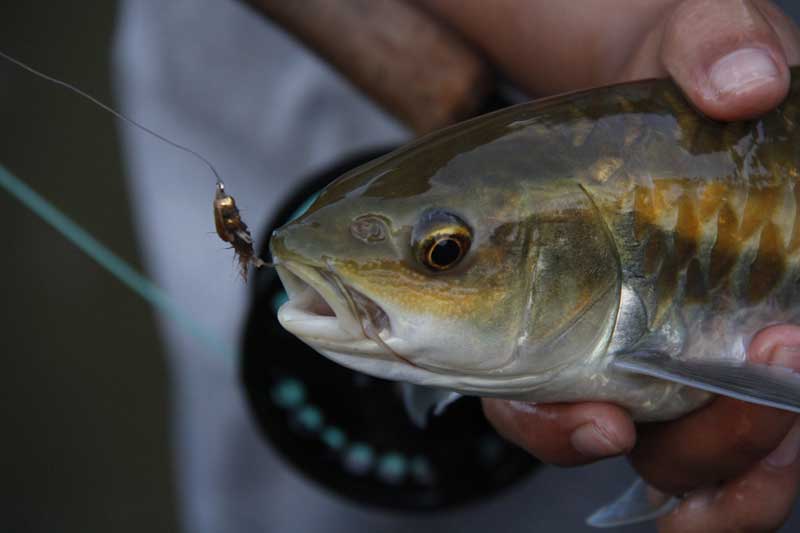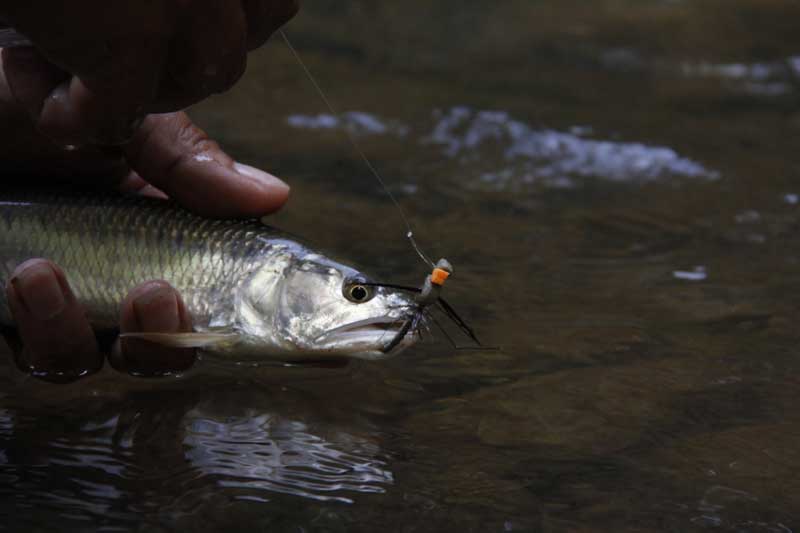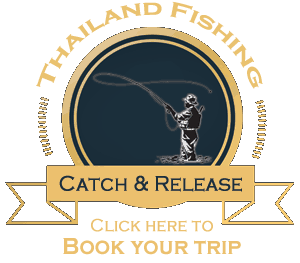Mahseer love cicadas and beetles, so big Hoppers, Wulffs and Cicada patterns are very effective.
The best flies for fly fishing in Thailand for Burmese Trout and various Mahseer fish species are very similar to those used stalking big Brown Trout.
The Mahseer have an equally flexible approach to feeding, and whilst equally wary, they repond positively to well-presented dry flies, nymphs and streamers. Just as trout do, the Mahseer focus primarily on whatever food source is currently abundant, but remain ever-aware of the plump cicadas, beetles, bugs and butterflies that regularly make inadvertent touch-downs on water.
Burmese Trout are also very responsive to both dry flies and nymhs…
A beetle provides 100 times more protein than a caddis nymph, and induces recklessly aggressive takes from even the tiniest of fish!
Dry Flies
Cicada hatches occur throughout northern Thailand in hot periods, especially towards the end of Cold Season in February – when rivers are low and clear. A variety of cicada species are on offer to a greedy fish, and they snap them up competitively. The various standard ‘big bug’ flies will entice interest;
- Dave’s Hopper #6 – #10
- Cicada #6 – #10
- Royal Wullf – #6
- Orange Stimulator #6 – #10
- Madame X Royal #6 – #10
 |
 |
| Royal Wulff | Made-X Hopper |
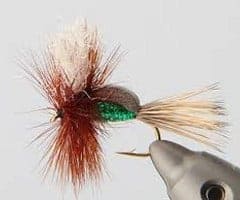 |
 |
| Humpy – Green Bottle | Cicada |
 |
 |
| Stimulator – Orange | Dave’s Hopper |
Overall, any large dry fly that floats high and dry, has wings and/or legs, and a good “bug” silhouette will work well as an “attractor” fly. A universal global favourite, the Royal Wulf, is an excellent choice here in northern Thailand, especially when used as a strike indicator with a #14 to #16 Pheasant Tail, Hare’s Ear or Hare & Copper bead-head, flashback nymph on a dropper.
Caddis are evident in the early morning and evenings, and sulphur-coloured mayflies hatches are sometimes seen.
- Elk Hair Caddis #14 – #16
- Parachute Adams #14 – #16
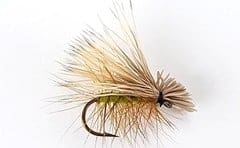 |
 |
| Elk Hair Caddis | Parachute Adams |
Nymphs
Examining the undersides of boulders in the freestone rivers and streams reveals an abundance of mayfly, stonefly and sundry caddis species in nymph stages. There are also many types of dragonfly nymphs, evidenced by the multiple variations of adult dragonflies that grace every waterway.
- Pheasant Tail
- Gold-Ribbed Hare’s Ear
- Hare & Copper
 |
 |
| Pheasant Tail | Hare & Copper |
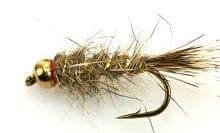 |
|
| Gold-Ribbed Hare’s Ear |
If you like to tie your own, do so in sizes #14 to #16 with a tungsten bead-head, and a flashback…Mahseer find these to be just as irresistable as a Brown trout does!
Note: the tungsten beadhead is important because it makes the nymphs sink far faster and deeper than standard brass beads.
Streamer Flies
The rivers, streams and lakes have an abundant and varied minnow population, in addition to the proliferation of juveniles on many larger fish species. Thus far, the following streamers have produced fish;
- Woolly Bugger #8 – #10 – olive, black, bead or conehead
- Zonker #8 – #10
 |
 |
| Zonker | Woolly Bugger |
Fruit & Berry Flies
There are a variety of small fruits and berries in tropical forests, and where these drop into the water, the fish will consume them. A little fingernail-sized orange/red/mauve berry is a common floating item, and a #12 – #14 salmon egg fly is not a bad option at times.
A local variation is the Cherry Bomb which emulates a riverside fruit which often falls into the rivers.
Fly Experimentation
This fishery is still in its infancy, so experimentation is on-going and there’s plenty of opportunity to throw out a fly that has never ever been cast on Thai waters. If you’ve got a favourite fly, feel free to bring it along!


